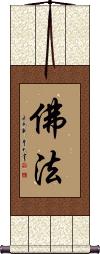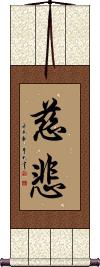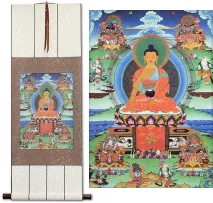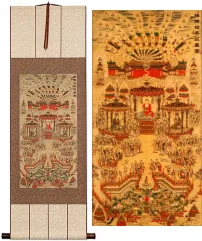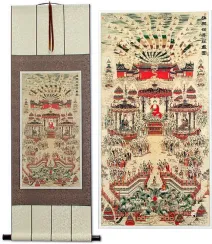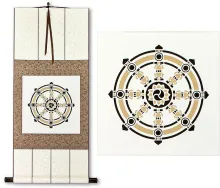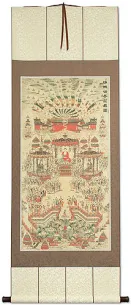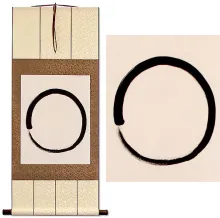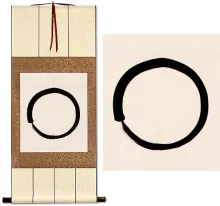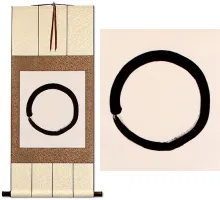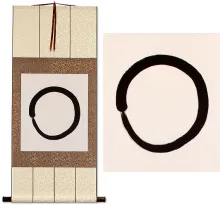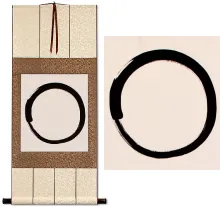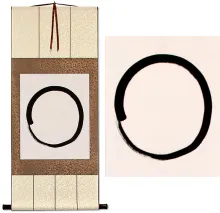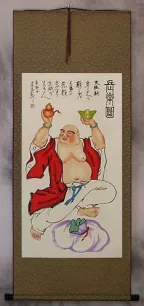Many custom options...
And formats...

Buddhist in Chinese / Japanese...
Buy a Buddhist calligraphy wall scroll here!
Personalize your custom “Buddhist” project by clicking the button next to your favorite “Buddhist” title below...
Koan
In the Buddhist context, 公案 is a Zen question for meditation.
From the Buddhist dictionary, this is:
Problems set by Zen masters, upon which thought is concentrated as a means to attain inner unity and illumination.
The secular meaning of this word can mean a judge's desk, a complex legal case, a contentious issue, a dossier, a case record, public laws, regulations, or case law.
Dharma / Buddhist Doctrine
Mercy / Compassion / Buddhist Loving Kindness
Besides the title above, 慈悲 can also be defined as clemency or lenience and sometimes the act of giving charity.
In the Buddhist context, it can be defined as “benevolence,” “loving-kindness and compassion,” or “mercy and compassion.”
This Buddhist virtue is perhaps the most important to employ in your life. All sentient beings that you encounter should be given your loving kindness. And trust me, however much you can give, it comes back. Make your life and the world a better place!
This Chinese/Japanese Buddhist term is the equivalent of Metta Karuna from Pali or Maitri Karuna from Sanskrit.
慈 can mean loving-kindness by itself.
悲 adds a component of sorrow, empathy, compassion, and sympathy for others.
See Also: Benevolence
Buddhist Monk
僧侶/僧侶 is a Japanese title for a Buddhist monk.
The first Kanji means Buddhist priest or monk by itself.
The second Kanji means follower or companion.
![]() Note, if you order this from the Japanese master calligrapher, the first character will look a bit more like the Kanji shown to the right than the Kanji shown above. Let us know if you have a preference, as both versions are technically-correct in both Chinese and Japanese.
Note, if you order this from the Japanese master calligrapher, the first character will look a bit more like the Kanji shown to the right than the Kanji shown above. Let us know if you have a preference, as both versions are technically-correct in both Chinese and Japanese.
This in-stock artwork might be what you are looking for, and ships right away...
Gallery Price: $200.00
Your Price: $88.88
Gallery Price: $200.00
Your Price: $69.88
Not the results for buddhist that you were looking for?
Below are some entries from our dictionary that may match your buddhist search...
| Characters If shown, 2nd row is Simp. Chinese |
Pronunciation Romanization |
Simple Dictionary Definition |
佛 see styles |
fó fo2 fo hotoke ほとけ |
More info & calligraphy: Buddhism / Buddha(surname) Hotoke Buddha, from budh to "be aware of", "conceive", "observe", "wake"; also 佛陀; 浮圖; 浮陀; 浮頭; 浮塔; 勃陀; 勃馱; 沒馱; 母馱; 母陀; 部陀; 休屠. Buddha means "completely conscious, enlightened", and came to mean the enlightener. he Chinese translation is 覺 to perceive, aware, awake; and 智 gnosis, knowledge. There is an Eternal Buddha, see e.g. the Lotus Sutra, cap. 16, and multitudes of Buddhas, but the personality of a Supreme Buddha, an Ādi-Buddha, is not defined. Buddha is in and through all things, and some schools are definitely Pan-Buddhist in the pantheistic sense. In the triratna 三寳 commonly known as 三寳佛, while Śākyamuni Buddha is the first "person" of the Trinity, his Law the second, and the Order the third, all three by some are accounted as manifestations of the All-Buddha. As Śākyamuni, the title indicates him as the last of the line of Buddhas who have appeared in this world, Maitreya is to be the next. As such he is the one who has achieved enlightenment, having discovered the essential evil of existence (some say mundane existence, others all existence), and the way of deliverance from the constant round of reincarnations; this way is through the moral life into nirvana, by means of self-abnegation, the monastic life, and meditation. By this method a Buddha, or enlightened one, himself obtains Supreme Enlightenment, or Omniscience, and according to Māhāyanism leads all beings into the same enlightenment. He sees things not as they seem in their phenomenal but in their noumenal aspects, as they really are. The term is also applied to those who understand the chain of causality (twelve nidānas) and have attained enlightenment surpassing that of the arhat. Four types of the Buddha are referred to: (1) 三藏佛the Buddha of the Tripiṭaka who attained enlightenment on the bare ground under the bodhi-tree; (2) 通佛the Buddha on the deva robe under the bodhi-tree of the seven precious things; (3) 別佛the Buddha on the great precious Lotus throne under the Lotus realm bodhi-tree; and (4) 圓佛the Buddha on the throne of Space in the realm of eternal rest and glory where he is Vairocana. The Hīnayāna only admits the existence of one Buddha at a time; Mahāyāna claims the existence of many Buddhas at one and the same time, as many Buddhas as there are Buddha-universes, which are infinite in number. |
僧 see styles |
sēng seng1 seng sou / so そう |
More info & calligraphy: Sangha / Order of Monks(1) monk; priest; (2) (abbreviation) (See 僧伽・そうぎゃ) sangha (the Buddhist community); (surname) Sou 僧伽 saṅgha, an assembly, collection, company, society. The corporate assembly of at least three (formerly four) monks under a chairman, empowered to hear confession, grant absolution, and ordain. The church or monastic order, the third member of the triratna. The term 僧 used alone has come to mean a monk, or monks in general. Also僧佉, 僧加, 僧企耶.; A fully ordained monk, i.e. a bhikṣu as contrasted with the śramaņa. |
切 see styles |
qiè qie4 ch`ieh chieh setsu せつ |
More info & calligraphy: Che(noun or adjectival noun) (1) (See 切に,切なる) eager; earnest; ardent; kind; keen; acute; (interjection) (2) (abbreviation) (also きり) (See 切る・3) OFF (on switch) To cut, carve; a whole; urgent; the 反切 system of spelling, i. e. the combination of the initial sound of one Chinese word with the final sound of another to indicate the sound of a third, a system introduced by translators of Buddhist works; v. 反. |
密 see styles |
mì mi4 mi mitsu みつ |
More info & calligraphy: Secret(noun or adjectival noun) (1) (ant: 疎・そ・1) dense; thick; crowded; (noun or adjectival noun) (2) close (relationship); intimate; (noun or adjectival noun) (3) minute; fine; careful; (noun or adjectival noun) (4) secret; (5) (abbreviation) {Buddh} (See 密教・みっきょう) esoteric Buddhism; secret Buddhist teachings; (surname, female given name) Mitsu Closed in; close together; intimate; quiet, still; secret, occult, esoteric; fine, small; contrasted with 顯 open, exoteric. Cf. 祕. |
意 see styles |
yì yi4 i i い |
More info & calligraphy: Idea / Thought / Meaning(1) feelings; thoughts; (2) meaning; (personal name) Kokoro Manas, the sixth of the ṣaḍāyatanas or six means of perception, i.e. sight, hearing, smell, taste, touch, and mind. Manas means "mind (in its widest sense as applied to all the mental powers), intellect, intelligence, understanding, perception, sense, conscience, will". M.W. It is "the intellectual function of consciousness", Keith. In Chinese it connotes thought, idea, intention, meaning, will; but in Buddhist terminology its distinctive meaning is mind, or the faculty of thought. |
法 see styles |
fǎ fa3 fa hou / ho ほう |
More info & calligraphy: Dharma / The Law(n,n-suf) (1) law; act; principle; (n,n-suf) (2) method; (n,n-suf) (3) {gramm} mood; (n,n-suf) (4) {Buddh} dharma; law; (female given name) Minori Dharma, 達磨; 曇無 (or 曇摩); 達摩 (or 達謨) Law, truth, religion, thing, anything Buddhist. Dharma is 'that which is held fast or kept, ordinance, statute, law, usage, practice, custom'; 'duty'; 'right'; 'proper'; 'morality'; 'character'. M. W. It is used in the sense of 一切 all things, or anything small or great, visible or invisible, real or unreal, affairs, truth, principle, method, concrete things, abstract ideas, etc. Dharma is described as that which has entity and bears its own attributes. It connotes Buddhism as the perfect religion; it also has the second place in the triratna 佛法僧, and in the sense of 法身 dharmakāya it approaches the Western idea of 'spiritual'. It is also one of the six media of sensation, i. e. the thing or object in relation to mind, v. 六塵. |
磬 see styles |
qìng qing4 ch`ing ching kei / ke けい |
More info & calligraphy: Khánhsounding stone; qing; ancient Chinese chime shaped like a chevron (inverted 'v'), orig. of stone, today often metal, in Japan primarily used at Buddhist temples; (given name) Kei A piece of flat stone or metal, used as a gong, or for musical percussion. |
禪 禅 see styles |
shàn shan4 shan yuzuri ゆずり |
More info & calligraphy: Zen / Chan / Meditation(out-dated kanji) (1) (Buddhist term) dhyana (profound meditation); (2) (abbreviation) Zen (Buddhism); (surname) Yuzuri To level a place for an altar, to sacrifice to the hills and fountains; to abdicate. Adopted by Buddhists for dhyāna, 禪 or 禪那, i.e. meditation, abstraction, trance. dhyāna is 'meditation, thought, reflection, especially profound and abstract religious contemplation'. M.W. It was intp. as 'getting rid of evil', etc., later as 靜慮 quiet meditation. It is a form of 定, but that word is more closely allied with samādhi, cf. 禪定. The term also connotes Buddhism and Buddhist things in general, but has special application to the 禪宗 q.v. It is one of the six pāramitās, cf. 波. There are numerous methods and subjects of meditation. The eighteen brahmalokas are divided into four dhyāna regions 'corresponding to certain frames of mind where individuals might be reborn in strict accordance with their spiritual state'. The first three are the first dhyāna, the second three the second dhyāna, the third three the third dhyāna, and the remaining nine the fourth dhyāna. See Eitel. According to Childers' Pali Dictionary, 'The four jhānas are four stages of mystic meditation, whereby the believer's mind is purged from all earthly emotions, and detached as it were from his body, which remains plunged in a profound trance.' Seated cross-legged, the practiser 'concentrates his mind upon a single thought. Gradually his soul becomes filled with a supernatural ecstasy and serenity', his mind still reasoning: this is the first jhāna. Concentrating his mind on the same subject, he frees it from reasoning, the ecstasy and serenity remaining, which is the second jhāna. Then he divests himself of ecstasy, reaching the third stage of serenity. Lastly, in the fourth stage the mind becomes indifferent to all emotions, being exalted above them and purified. There are differences in the Mahāyāna methods, but similarity of aim. |
竜 see styles |
lóng long2 lung ryou / ryo りょう |
More info & calligraphy: Dragon / Emperor Symbol(1) dragon (esp. a Chinese dragon); (2) naga; semi-divine human-cobra chimera in Hindu and Buddhist mythology; (surname, female given name) Ryō |
聖 圣 see styles |
shèng sheng4 sheng hijiri ひじり |
More info & calligraphy: The Saint(1) highly virtuous monk; (2) (honorific or respectful language) monk; (3) Buddhist solitary; (4) (See 高野聖・1) Buddhist missionary; (5) saint (i.e. a virtuous person); (6) (archaism) (honorific or respectful language) emperor; (7) (in form 〜の聖) master; expert; (female given name) Mina ārya; sādhu; a sage; wise and good; upright, or correct in all his character; sacred, holy, saintly. |
迦 see styles |
jiā jia1 chia ka |
More info & calligraphy: KyaTranslit. ka, kā; cf. 伽; 各; 嘎; 揭; 柯; 箇; 紺; 羯. |
道 see styles |
dào dao4 tao dou / do どう |
More info & calligraphy: Daoism / Taoism(1) (abbreviation) (See 道・みち・1) road; path; street; route; (2) (See 道・みち・5) way; set of practices; rules for conducting oneself; (3) (abbreviation) (in Japanese schools) (See 道徳教育) moral education; (4) Buddhist teachings; (5) Taoism; (6) administrative region of Japan (Hokkaido); (7) (hist) administrative region of Japan (Tokaido, Tosando, etc.); (8) province (administrative region of Korea); (9) circuit (administrative region of China); (10) (hist) province (Tang-era administrative region of China); (personal name) Wataru mārga. A way, road; the right path; principle, Truth, Reason, Logos, Cosmic energy; to lead; to say. The way of transmigration by which one arrives at a good or bad existence; any of the six gati, or paths of destiny. The way of bodhi, or enlightenment leading to nirvāṇa through spiritual stages. Essential nirvāṇa, in which absolute freedom reigns. For the eightfold noble path v. 八聖道.; The two Ways: (1) (a) 無礙道 or 無間道 The open or unhindered way, or the way of removing all obstacles or intervention, i. e. all delusion; (b) 解脫道 the way of release, by realization of truth. (2) (a) 難行道 The hard way of "works", i. e. by the six pāramitā and the disciplines. (b) 易行道 the easy way salvation, by the invocation of Amitābha. (3) (a) 有漏道 The way of reincarnation or mortality; (b) 無漏 the enlightened way of escape from the miseries of transmigration. (4) (a) 教道 The way of instruction; (b) 證道 the way of realization. (5) The two lower excretory organs. |
龍 龙 see styles |
lóng long2 lung riyou / riyo りよう |
More info & calligraphy: Dragon(out-dated kanji) (1) dragon (esp. a Chinese dragon); (2) naga; semi-divine human-cobra chimera in Hindu and Buddhist mythology; (personal name) Riyou A dragon, dragon-like, imperial; tr. for nāga, which means snake, serpent; also elephant, elephantine, serpent-like, etc., cf. 那. |
三昧 see styles |
sān mèi san1 mei4 san mei sanmai; zanmai さんまい; ざんまい |
More info & calligraphy: Samadhi(1) (さんまい only) {Buddh} samadhi (state of intense concentration achieved through meditation) (san:); (suffix noun) (2) (usu. ざんまい) being immersed in; being absorbed in; indulging in; doing to one's heart's content; (suffix noun) (3) (usu. ざんまい) prone to; apt to; (given name) Sanmai (三昧地) Samādhi, "putting together, composing the mind, intent contemplation, perfect absorption, union of the meditator with the object of meditation." (M. W.) Also 三摩地 (三摩提, 三摩帝, 三摩底). Interpreted by 定 or 正定, the mind fixed and undisturbed; by 正受 correct sensation of the object contemplated; by 調直定 ordering and fixing the mind; by 正心行處 the condition when the motions of the mind are steadied and harmonized with the object; by 息慮凝心 the cessation of distraction and the fixation of the mind; by 等持 the mind held in equilibrium; by 奢摩他, i.e. 止息 to stay the breathing. It is described as concentration of the mind (upon an object). The aim is 解脫, mukti, deliverance from all the trammels of life, the bondage of the passions and reincarnations. It may pass from abstraction to ecstasy, or rapture, or trance. Dhyāna 定 represents a simpler form of contemplation; samāpatti 三摩鉢底 a stage further advanced; and samādhi the highest stage of the Buddhist equivalent for Yoga, though Yoga is considered by some as a Buddhist development differing from samādhi. The 翻譯名義 says: 思專 when the mind has been concentrated, then 志一不分 the will is undivided; when 想寂 active thought has been put to rest, then 氣虛神朗 the material becomes etherealized and the spirit liberated, on which 智 knowledge, or the power to know, has free course, and there is no mystery into which it cannot probe. Cf. 智度論 5, 20, 23, 28; 止觀 2; 大乘義章 2, 9, 1 3, 20, etc. There are numerous kinds and degrees of samādhi. |
佛法 see styles |
fó fǎ fo2 fa3 fo fa buppō |
More info & calligraphy: Dharma / Buddhist Doctrinebuddhadharma; the Dharma or Law preached by the Buddha, the principles underlying these teachings, the truth attained by him, its embodiment in his being. Buddhism. |
僧伽 see styles |
sēng qié seng1 qie2 seng ch`ieh seng chieh sougya / sogya そうぎゃ |
More info & calligraphy: Sanghasangha (the Buddhist community) (san: samgha) (Skt. saṃgha) |
僧侶 僧侣 see styles |
sēng lǚ seng1 lu:3 seng lü souryo / soryo そうりょ |
More info & calligraphy: Buddhist Monk{Buddh} priest; monk; bonze Monastic companions, or company. |
參禪 参禅 see styles |
cān chán can1 chan2 ts`an ch`an tsan chan noshi wo ri |
More info & calligraphy: Zen UnderstandingTo inquire, discuss, seek religious instruction. |
合掌 see styles |
hé zhǎng he2 zhang3 ho chang gasshou / gassho がっしょう |
More info & calligraphy: Gassho(n,vs,vi) (1) pressing one's hands together in prayer; (2) triangular frame of a thatched roof; (expression) (3) (at the end of Buddhist correspondence) (See 敬具) yours sincerely; yours truly; sincerely yours; (surname) Gasshou the gesture of joining one's palms and putting them to the breast as an expression of reverence |
因緣 因缘 see styles |
yīn yuán yin1 yuan2 yin yüan innen |
More info & calligraphy: Fate / Opportunity / Chancehetupratyaya. Cause; causes; 因 hetu, is primary cause, 緣 pratyaya, secondary cause, or causes, e. g. a seed is 因, rain, dew, farmer, etc., are 緣. The 十二因緣 twelve nidānas or links are 'the concatenation of cause and effect in the whole range of existence'. |
如來 如来 see styles |
rú lái ru2 lai2 ju lai nyorai にょらい |
More info & calligraphy: Tathagata(out-dated kanji) Tathagata; perfected one (suffix of high-ranking Buddhist deities) tathāgata, 多陀阿伽陀 q. v.; 怛他揭多 defined as he who comes as do all other Buddhas; or as he who took the 眞如 zhenru or absolute way of cause and effect, and attained to perfect wisdom; or as the absolute come; one of the highest titles of a Buddha. It is the Buddha in his nirmāṇakāya, i. e. his 'transformation' or corporeal manifestation descended on earth. The two kinds of Tathāgata are (1) 在纏 the Tathāgata in bonds, i. e. limited and subject to the delusions and sufferings of life, and (2) 出纏 unlimited and free from them. There are numerous sutras and śāstras bearing this title of 如來 rulai. |
学生 see styles |
gakushou; gakusou / gakusho; gakuso がくしょう; がくそう |
(1) (archaism) Heian-period student of government administration; (2) (archaism) Buddhist scholar; researcher at a Buddhist temple; person studying Buddhism; (3) (archaism) learning; scholarship; (personal name) Manabu |
布施 see styles |
bù shī bu4 shi1 pu shih fuse ふせ |
More info & calligraphy: Dana: Almsgiving and Generosity(n,vs,vi) (1) {Buddh} alms-giving; charity; (n,vs,vi) (2) {Buddh} offerings (usu. money) to a priest (for reading sutras, etc.); (surname) Fuho dāna 檀那; the sixth pāramitā, almsgiving, i. e. of goods, or the doctrine, with resultant benefits now and also hereafter in the forms of reincarnation, as neglect or refusal will produce the opposite consequences. The 二種布施 two kinds of dāna are the pure, or unsullied charity, which looks for no reward here but only hereafter; and the sullied almsgiving whose object is personal benefit. The three kinds of dāna are goods, the doctrine, and courage, or fearlessness. The four kinds are pens to write the sutras, ink, the sutras themselves, and preaching. The five kinds are giving to those who have come from a distance, those who are going to a distance, the sick, the hungry, those wise in the doctrine. The seven kinds are giving to visitors, travellers, the sick, their nurses, monasteries, endowments for the sustenance of monks or nuns, and clothing and food according to season. The eight kinds are giving to those who come for aid, giving for fear (of evil), return for kindness received, anticipating gifts in return, continuing the parental example of giving, giving in hope of rebirth in a particular heaven, in hope of an honoured name, for the adornment of the heart and life. 倶舍論 18. |
日蓮 日莲 see styles |
rì lián ri4 lian2 jih lien nichiren にちれん |
More info & calligraphy: NichirenNichiren, the Japanese founder, in A. D. 1252, of the 日蓮宗 Nichiren sect, which is also known as the 法華宗 or Lotus sect. Its chief tenets are the three great mysteries 三大祕法, representing the trikāya: (1) 本尊 or chief object of worship, being the great maṇḍala of the worlds of the ten directions, or universe, i. e. the body or nirmāṇakāya of Buddha; (2) 題目 the title of the Lotus Sutra 妙法蓮華經 Myo-ho-ren-gwe-kyo, preceded by Namo, or, 'Adoration to the scripture of the lotus of the wonderful law, ' for it is Buddha's spiritual body; (3) 戒壇 the altar of the law, which is also the title of the Lotus as above; the believer, wherever he is, dwells in the Pure-land of calm light 寂光淨土, the saṃbhogakāya. |
法輪 法轮 see styles |
fǎ lún fa3 lun2 fa lun hourin / horin ほうりん |
More info & calligraphy: Eternal Wheel of Life{Buddh} (See 輪宝,転法輪) the teachings of Buddha (as likened to the Dharmachakra, originally a wheel-like weapon used to destroy the evils of mankind); Buddhist doctrine; (surname) Noriwa dharmacakra, the Wheel of the Law, Buddha-truth which is able to crush all evil and all opposition, like Indra's wheel, and which rolls on from man to man, place to place, age to age. 轉法輪To turn, or roll along the Law-wheel, i.e. to preach Buddha-truth. |
浄土 see styles |
joudo / jodo じょうど |
More info & calligraphy: Pure Land / Jodo |
無我 无我 see styles |
wú wǒ wu2 wo3 wu wo muga むが |
More info & calligraphy: Selflessness(1) selflessness; self-effacement; self-renunciation; (2) {Buddh} anatta; anatman; doctrine that states that humans do not possess souls; (female given name) Muga anātman; nairātmya; no ego, no soul (of an independent and self-contained character), impersonal, no individual independent existence (of conscious or unconscious beings, anātmaka). The empirical ego is merely an aggregation of various elements, and with their disintegration it ceases to exist; therefore it has nm ultimate reality of its own, but the Nirvāṇa Sūtra asserts the reality of the ego in the transcendental realm. The non-Buddhist definition of ego is that it has permanent individuality 常一之體 and is independent or sovereign 有主宰之用. When applied to men it is 人我, when to things it is 法我. Cf. 常 11. |
聖天 圣天 see styles |
shèng tiān sheng4 tian1 sheng t`ien sheng tien shouten; shouden / shoten; shoden しょうてん; しょうでん |
More info & calligraphy: GaneshĀryadeva |
自然 see styles |
zì rán zi4 ran2 tzu jan jinen じねん |
More info & calligraphy: Nature(n,adv) (dated) occurring naturally (without human influence); (female given name) Minori svayaṃbhū, also 自爾; 法爾 self-existing, the self-existent; Brahmā, Viṣṇu, and others; in Chinese it is 'self-so', so of itself, natural, of course, spontaneous. It also means uncaused existence, certain sects of heretics 自然外道 denying Buddhist cause and effect and holding that things happen spontaneously. |
観音 see styles |
mine みね |
More info & calligraphy: Goddess of Compassion |
Click here for more buddhist results from our dictionary
The following table may be helpful for those studying Chinese or Japanese...
| Title | Characters | Romaji (Romanized Japanese) | Various forms of Romanized Chinese | |
| Koan | 公案 | kouan / koan | gōng àn / gong1 an4 / gong an / gongan | kung an / kungan |
| Dharma Buddhist Doctrine | 佛法 | fó fǎ / fo2 fa3 / fo fa / fofa | ||
| Mercy Compassion Buddhist Loving Kindness | 慈悲 | ji hi / jihi | cí bēi / ci2 bei1 / ci bei / cibei | tz`u pei / tzupei / tzu pei |
| Buddhist Monk | 僧侶 / 僧侶 僧侶 | sou ryo / souryo / so ryo | ||
| In some entries above you will see that characters have different versions above and below a line. In these cases, the characters above the line are Traditional Chinese, while the ones below are Simplified Chinese. | ||||
Successful Chinese Character and Japanese Kanji calligraphy searches within the last few hours...

